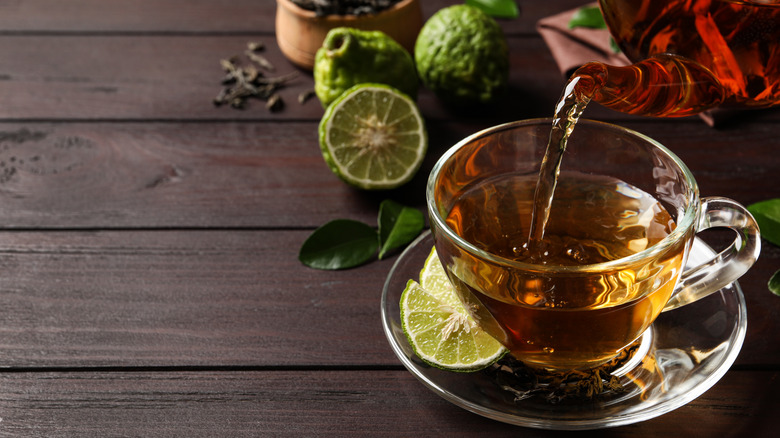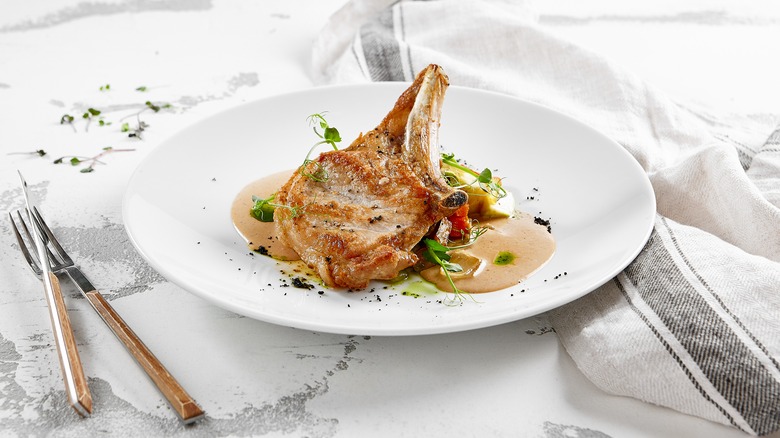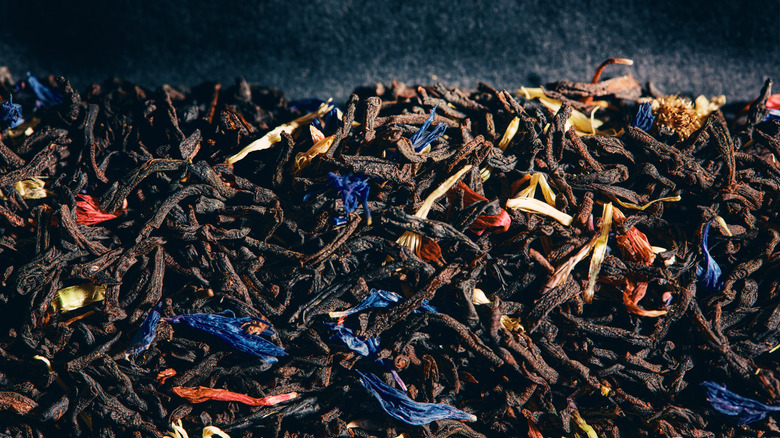The Ingredient That Will Have Everyone Guessing The Secret To Your Pan Sauce
A pan sauce is an easy way to elevate a humdrum pork chop or seared chicken breast into something delicious and memorable. You could stick with the usual stand-bys like red wine and Dijon or lemon caper butter sauce, but using a few Earl Grey tea bags will give your pan sauce a citrusy hint that will leave your dinner guests stumped.
Usually associated with afternoon tea, Earl Grey might seem like an odd ingredient to include in a pan sauce. After all, its second most popular application is in desserts like scrummy Earl Grey tea shortbread sugar cookies. But the citrus notes of Earl Grey tea pair exceptionally well with meats like pork and chicken — think of how delicious pork carnitas or orange chicken are. This is all thanks to what makes Earl Grey unique in the world of tea – the bergamot orange. Black tea leaves are mixed with bergamot oil and dried rinds, which lends the familiar citrus flavor to the tea – and makes it the ideal flavor for your pan sauce.
A basic pan sauce recipe can be transformed with Earl Grey
If you know how to make a successful elevated pan sauce, you can tweak the basic recipe with a few Earl Grey tea bags. The technique involves removing your seared meat, tossing in a pat of butter and some finely minced shallot, and then scraping up all the delicious browned bits, a.k.a. the fond. You can deglaze the pan with water, chicken broth, white wine, or a combination, but the key is tossing in two Earl Grey tea bags — you don't want to be overwhelmed with the flavor — and a splash of orange juice (to amplify the citrus flavor). While it's simmering, you can enjoy the fragrant steam as it reduces until it's able to just barely coat the back of a spoon. You will, of course, want to remove the tea bags and give the sauce a taste for seasoning. You can use a sweetener, like honey or maple syrup, if desired, or forgo it altogether.
If you find that it won't reduce and thicken, try making a roux with a tablespoon of flour and 2 tablespoons of cold water and whisk in. Make sure to finish the sauce with cold cubed unsalted butter, whisking after each cube so the sauce doesn't break. After you've given it another taste for seasoning, you can strain it if you prefer a smoother sauce.
Earl Grey is a surprisingly versatile savory ingredient
Besides the requisite sweet applications of Earl Grey tea — anything from tea cakes to biscuits — it makes an ideal accompaniment for a variety of meat dishes, either as a rub, in a sauce, or even in a marinade. Smoky lapsang souchong is often used as a dry rub for grilled meats, but this can easily be modified by using Earl Grey, which also pairs well with herbs like thyme and tarragon for a bright, citrusy twist on a seasoning blend. It's especially delicious on steaks headed for the cast iron skillet or grill.
As a marinade or brine, Earl Grey works well for other proteins besides beef or pork. The citrus notes of bergamot perfectly complement things like chicken, lamb, scallops, or even salmon. Give some Early Grey tea-brined chicken breasts a whirl or a salmon filet infused with Earl Grey paired with a citrusy mayonnaise. Lamb short loin marinated in Earl Grey, orange juice, and soy sauce and served with a fennel salad produces a succulent, fresh take on lamb.


